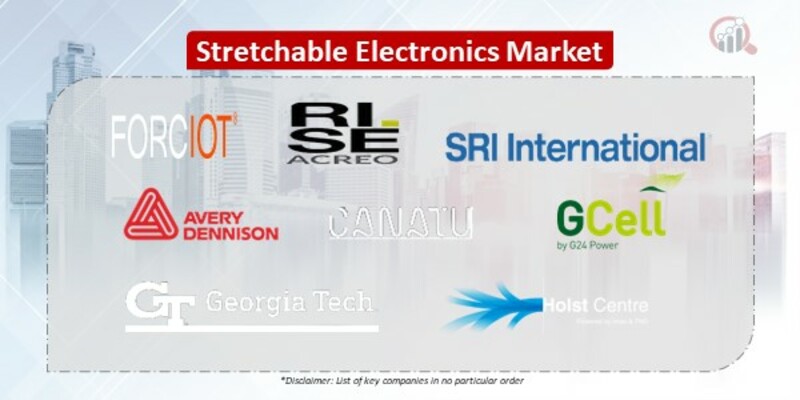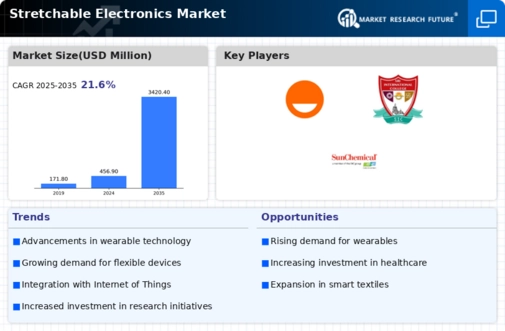Top Industry Leaders in the Stretchable Electronics Market

Competitive Landscape of Stretchable Electronics Market
The stretchable electronics market, with its ability to conform to curved and moving surfaces, presents a future brimming with possibilities. While still in its nascent stages, the market is attracting players from diverse backgrounds, leading to a dynamic and rapidly evolving competitive landscape. To navigate this terrain, understanding the current strategies, key players, and future trends is crucial.
Some of the Stretchable Electronics companies listed below:
- Forciot Ltd
- RISE Acreo
- SRI INTERNATIONAL
- AVERY DENNISON CORPORATION
- CAMBRIOS
- Canatu Oy
- GCell
- Georgia Institute of Technology
- Holst Centre
Strategies Adopted by Key Players:
Players are adopting diverse strategies to gain a foothold in the market:
- Large Established Companies: Technology giants leverage their extensive R&D and manufacturing capabilities to diversify into stretchable electronics, focusing on displays and wearable devices.
- Start-ups and SMEs: With their agility and focus on specific niches, start-ups are developing innovative solutions for healthcare, robotics, and human-computer interactions.
- Material Suppliers: Chemical companies are developing stretchable conductive polymers and substrates, becoming crucial partners in the ecosystem.
- Contract Manufacturers: Specializing in custom fabrication techniques, companies offer their expertise to companies lacking in-house manufacturing capabilities.
Factors for Market Share Analysis:
Determining market share in this nascent environment requires a nuanced approach. Traditional metrics like revenue and unit shipments might not fully capture the picture. Here are some critical factors to consider:
- Technology Leadership: Companies pioneering novel materials, fabrication techniques, and device architectures gain an edge. Intellectual property plays a significant role, granting exclusivity in specific niche applications.
- Application Focus: Targeting high-value applications like healthcare or advanced wearables offers higher margins and faster growth compared to lower-tier consumer electronics.
- Vertical Integration: Companies with control over material synthesis, device fabrication, and integration into final products have a cost advantage and tighter quality control.
- Collaboration and Partnerships: Strategic partnerships with universities, research institutions, and established players in adjacent industries accelerate innovation and market access.
New and Emerging Companies:
- Startups: A wave of innovative startups is disrupting the market with novel materials, fabrication methods, and applications. Companies are pushing the boundaries of stretchable sensors, energy harvesting, and human-machine interfaces.
- Universities and Research Institutions: Academic institutions are playing a vital role in fundamental research and development, leading to breakthroughs in materials science, device design, and manufacturing processes. Their collaborations with industry players accelerate technology transfer and commercialization.
Latest Company Updates:
Sep 2023 The rapidly developing AD Stretch accelerator program will now include additional challenges and a worldwide reach with the debut of Cohort 03, according to Avery Dennison Corporation. Cohort 03 will concentrate on three areas of challenge: developing materials for next-generation energy storage, optimizing customer experiences, and enhancing sustainability. Startups worldwide are invited to participate in the program and work together to address real business problems. AD Stretch provides entrepreneurs with demonstrated sales and go-to-market expertise, the capacity for innovation, and the vigor to collaborate with Fortune 500 company Avery Dennison with nondilutive pilot-based accelerator programs. The accelerator seeks to combine Avery Dennison's extensive technical, financial, and R&D resources with companies to produce solutions that have a significant impact. Cohort 3 throws fresh difficulties at accelerator startups, focusing on consumer experience, sustainability, and next-generation storage materials. The objective for startups chosen to take on storage materials difficulties is to enhance battery performance by using materials that can boost energy density, efficiency, and safety.
